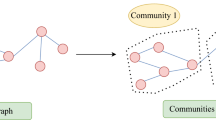Abstract
It is important to identify community structures for characterizing and understanding complex systems. Community detection models, like stochastic models and modularity maximization models, lack of the ability of nonlinear mapping, which leads to unsatisfactory performance when detecting communities of complex real-world networks. To address this issue, we propose a nonlinear method based on Convolutional Auto-Encoder (ConvAE) to improve the cohesiveness of community detection. We combine the convolution neural network and auto-encoder to improve the ability of nonlinear mapping of the proposed model. Moreover, to better characterize relations between nodes, we redefine the similarity between nodes for preprocessing the input data. We conduct extensive experiments on both the synthetic networks and real-world networks, and the results demonstrate the effectiveness of the proposed method and the superior performance over traditional methods and other deep learning based methods.
Supported by organization x.
Access this chapter
Tax calculation will be finalised at checkout
Purchases are for personal use only
Similar content being viewed by others
References
Krizhevsky, A., Sutskever, I., Hinton, G.: ImageNet classification with deep convolutional neural networks. In: Proceedings of the Advances in Neural Information Processing Systems, pp. 1097–1105 (2012)
Lancichinetti, A., Fortunato, S., Radicchi, F.: Benchmark graphs for testing community detection algorithms. Phys. Rev. E 78(4), 046110 (2008)
Ball, B., Karrer, B., Newman, M.E.J.: Efficient and principled method for detecting communities in networks. Phys. Rev. E 84(2), 036103 (2011)
Karrer, B., Newman, M.E.J.: Stochastic blockmodels and community structure in networks. Phys. Rev. E 83(1), 016107 (2011)
Schölkopf, B., Platt, J., Hofmann, T.: Greedy layer-wise training of deep networks. In: International Conference on Neural Information Processing Systems, pp. 153–160 (2006)
Ansótegui, C., Giráldez-Cru, J., Levy, J.: The community structure of SAT formulas. In: Cimatti, A., Sebastiani, R. (eds.) SAT 2012. LNCS, vol. 7317, pp. 410–423. Springer, Heidelberg (2012). https://doi.org/10.1007/978-3-642-31612-8_31
Kemp, C., Tenenbaum, J.B., Griffiths, T.L., Yamada, T., Ueda, N.: Learning systems of concepts with an infinite relational mode. In: National Conference on Artificial Intelligence, pp. 381–388 (2006)
Knuth, D.E.: The Stanford GraphBase: A Platform for Combinatorial Computing, pp. 41–43. ACM, Quezon City (1993)
Liou, C.Y., Cheng, W.C., Liou, J.W., Liou, D.R.: Autoencoder for words. Neurocomputing 139(139), 84–96 (2014)
Watts, D.J., Strogatz, S.H.: Collective dynamics of ‘small-world’ networks. Nature 393(6684), 440–442 (1998)
Jin, D., Chen, Z., He, D., Zhang, W.: Modeling with node degree preservation can accurately find communities. Math. Biosci. 269, 117–129 (2015)
Wu, F., Huberman, B.A.: Finding communities in linear time: a physics approach. Eur. Phys. J. B 38(2), 331–338 (2004)
Bourlard, H., Kamp, Y.: Auto-association by multilayer perceptrons and singular value decomposition. Biol. Cybern. 59(4–5), 291–294 (1988)
Psorakis, I., Roberts, S., Ebden, M., Sheldon, B.: Overlapping community detection using Bayesian non-negative matrix factorization. Phys. Rev. E 83(2), 066114 (2011)
Duch, J., Arenas, A.: Community detection in complex networks using extremal optimization. Phys. Rev. E 72(2), 027104 (2005)
Shang, J.W., Wang, C.K., Xin, X., Ying, X.: Community detection algorithm based on deep sparse auto-encoder. Ruan Jian Xue Bao/J. Softw. 28(3), 648–662 (2017). (in Chinese)
Xie, J., Kelley, S., Szymanski, B.K.: Overlapping community detection in networks: the state of the art and comparative study. ACM Comput. Surv. 45(4), 1–37 (2013)
Nowicki, K., Snijders, T.A.B.: Estimation and prediction for stochastic blockstructures. Publ. Am. Stat. Assoc. 96(455), 1077–1087 (2001)
Rohe, K., Chatterjee, S., Yu, B.: Spectral clustering and the high-dimensional stochastic blockmodel. Ann. Stat. 39(4), 1878–1915 (2010)
Adamic, L., Glance, N.: The political blogosphere and the 2004 US election: divided they blog. In: Proceedings of the 3rd International Workshop on Link Discovery, vol. 62, no. 1, pp. 36–43. ACM (2005)
Yang, L., Cao, X., He, D., Wang, C., Wang, X.: Modularity based community detection with deep learning. In: International Joint Conference on Artificial Intelligence, pp. 2252–2258 (2016)
Newman, M.E.J.: Modularity and community structure in networks. Proc. Natl. Acad. Sci. 103(23), 8577–8582 (2006)
Newman, M.E.J.: Fast algorithm for detecting community structure in networks. Phys. Rev. E 69(6), 066133 (2004)
Girvan, M., Newman, M.E.J.: Community structure in social and biological networks. Proc. Natl. Acad. Sci. U.S.A. 99(12), 7821 (2002)
Gleiser, P.M., Danon, L.: Community structure in Jazz. Adv. Complex Syst. 6(04), 565 (2003)
Horn, R.A., Johnson, C.R.: Matrix Analysis, emphGraduate Texts in Mathematics, pp. 176–180. Cambridge University Press, Cambridge (1990)
Wang, R.S., Zhang, S., Wang, Y., Zhang, X.S., Chen, L.: Clustering complex networks and biological networks by nonnegative matrix factorization with various similarity measures. Neurocomputing 72(1), 134–141 (2008)
Fortunato, S., Castellano, C.: Community structure in graphs. In: Meyers, R. (ed.) Computational Complexity, pp. 490–512. Springer, New York (2012). https://doi.org/10.1007/978-1-4614-1800-9
Zhang, S., Wang, R.S., Zhang, X.S.: Uncovering fuzzy community structure in complex networks. Phys. Rev. E 76(4), 046103 (2007)
Raghavan, U.N., Albert, R., Kumara, S.: Near linear time algorithm to detect community structures in large-scale networks. Phys. Rev. E 76(2), 036106 (2007)
Zachary, W.: An information flow model for conflict and fission in small groups. J. Anthropol. Res. 33(4), 452–473 (1977)
Lecun, Y., Bottou, L., Bengio, Y., Haffner, P.: Gradient-based learning applied to document recognition. Proc. IEEE 86(11), 2278–2324 (1998)
Zhang, Y., Yeung, D.: Overlapping community detection via bounded nonnegative matrix tri-factorization. In: Proceedings of the 18th ACM SIGKDD International Conference on Knowledge Discovery and Data Mining, pp. 606–614 (2012)
Acknowledgments
This work is supported by the Natural Science Foundation of China (No. 61672276), Natural Science Foundation of Jiangsu Province of China (No. BK20161406).
Author information
Authors and Affiliations
Corresponding author
Editor information
Editors and Affiliations
Rights and permissions
Copyright information
© 2019 Springer Nature Singapore Pte Ltd.
About this paper
Cite this paper
Li, C., Shi, W., Shang, L. (2019). Latent Feature Representation for Cohesive Community Detection Based on Convolutional Auto-Encoder. In: Jin, H., Lin, X., Cheng, X., Shi, X., Xiao, N., Huang, Y. (eds) Big Data. BigData 2019. Communications in Computer and Information Science, vol 1120. Springer, Singapore. https://doi.org/10.1007/978-981-15-1899-7_27
Download citation
DOI: https://doi.org/10.1007/978-981-15-1899-7_27
Published:
Publisher Name: Springer, Singapore
Print ISBN: 978-981-15-1898-0
Online ISBN: 978-981-15-1899-7
eBook Packages: Computer ScienceComputer Science (R0)





